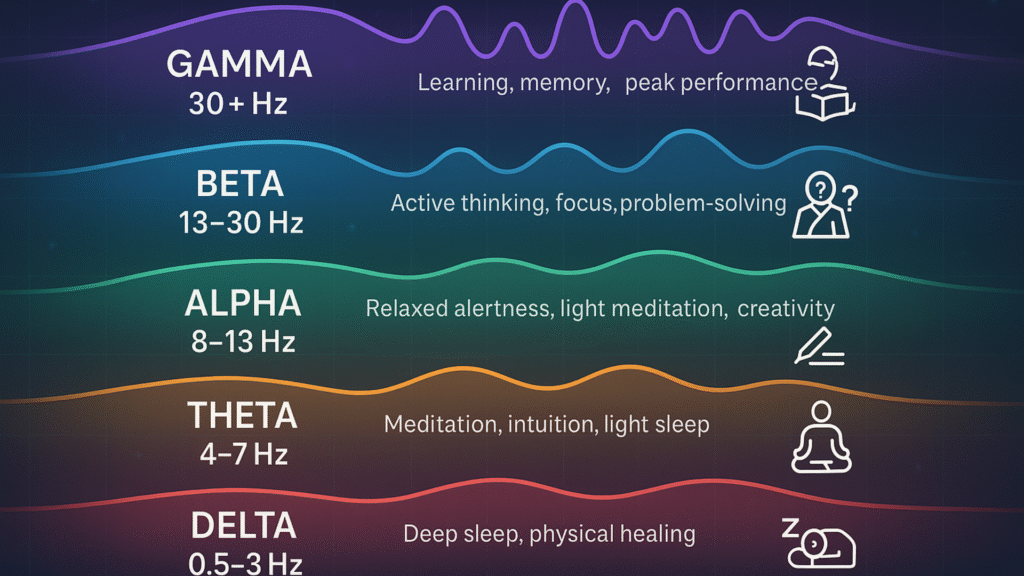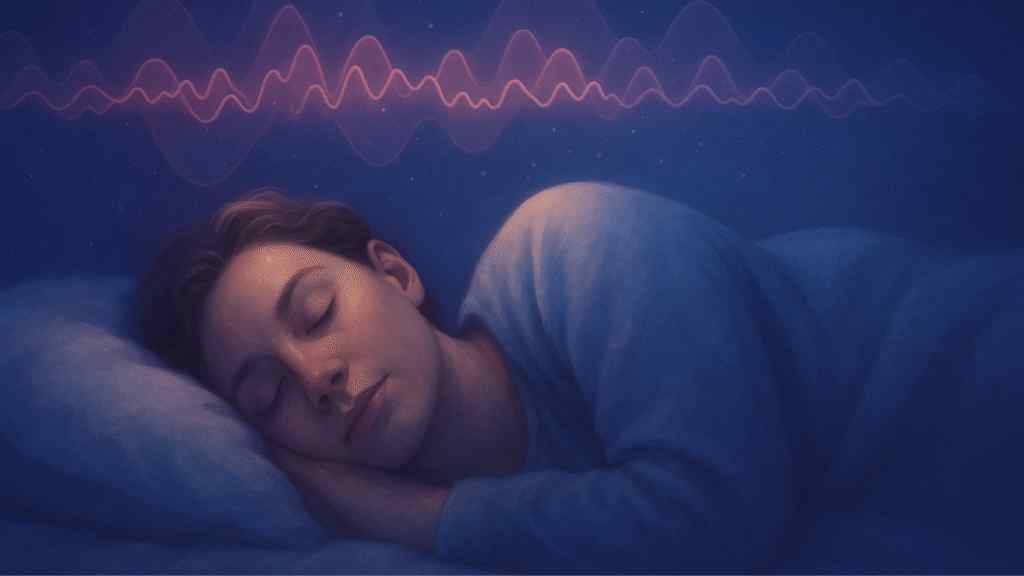The human brain is always active, producing patterns of electrical signals called brain waves. Each brain wave frequency corresponds to a different mental state, from restful sleep to sharp concentration. By exploring how these frequencies function, we can better understand consciousness and cognitive performance, setting the stage for innovations like the Theta Chamber to support mental wellness.
Understanding Brain Waves and Their Frequencies
Brain waves are rhythmic patterns of electrical activity in the brain that influence how we think, feel, and function. Each brain wave frequency corresponds to a specific state of consciousness, from deep rest to peak focus. These frequencies guide mental states and offer insight into how different brain regions work together to shape perception, behavior, and awareness.
What Are Brain Waves?
Brain waves are created by synchronized electrical impulses generated by groups of neurons communicating across different brain regions. These wave patterns are measured using electrodes placed on the scalp through a process called electroencephalography (EEG). Research has shown that distinct brainwave frequencies are linked to various states of awareness, learning, and memory. Each type of brain wave plays an important role in how the brain functions, reacts, and adapts.
Brain Wave Frequency Categories and Their Functions

Brainwave frequencies are grouped into distinct categories based on their speed, measured in hertz. These different frequency bands reflect specific mental and physical states and can be observed using electrodes on the surface of the scalp. Each type of brainwave plays a unique role in brain activity, affecting cognition, emotion, sleep, and awareness across different areas of the brain.
Delta Waves: The Foundation of Deep Rest
Delta waves are the slowest of all brainwave frequencies, typically ranging from 0.5 to 3 Hz. These low frequency waves are most commonly observed during deep sleep, particularly in slow wave sleep. Delta waves occur when brain activity slows to a restorative state, with minimal conscious thought.
During this brainwave state, the brain signals a shift toward deep physical rest. Delta waves are involved in the regulation of the sleep cycle and are strongly linked to healing processes in the body. This includes hormone regulation, tissue repair, and overall cellular recovery.
Researchers have found that delta wave activity supports immune function and reduces inflammation. These patterns are often observed across the entire cortex during the deepest stages of non-REM sleep, allowing the body and brain to restore energy and function.

Theta Waves: Unlocking Deep Relaxation and Creativity
Theta waves occur at a frequency of 4 to 7 Hz and represent a transition between wakefulness and sleep. These waves are commonly observed during REM sleep and moments of drowsiness. Theta brain activity is also associated with deep meditative states and daydreaming.
In this brainwave state, the cortex shows patterns of synchronized activity that foster creativity, emotional release, and heightened intuition. Different areas of the brain begin to interact in non-linear ways, opening the door to visualization, insight, and internal imagery.
Theta waves have been linked to emotional healing, reduced stress, and access to unconscious memories. They often appear during visualization exercises and are useful in therapeutic settings where relaxation and openness are required for progress.
Alpha Waves: The Bridge Between Conscious and Subconscious
Alpha waves typically range between 8 and 13 Hz and are most prominent when a person is calm, alert, and at rest. This frequency band is seen when someone closes their eyes or enters a meditative state. Alpha rhythms are often measured over posterior cortical areas but can involve the entire cortex.
Alpha brainwave activity reflects a relaxed but awake brain, often described as the alpha state. This is the state where the brain begins to disengage from external sensory input and turn inward, enhancing calm focus and mind-body awareness.
Researchers have shown that alpha waves are involved in tasks requiring self control, present-moment attention, and light introspection. They support a transition into deeper mental states and allow different brain regions to synchronize smoothly for integration and reflection.
Beta Waves: From Low Beta to High Beta States
Beta waves occur in the frequency range of 13 to 30 Hz and are commonly divided into low beta and high beta bands. These patterns are dominant during active thinking and problem-solving tasks. Low beta supports focused attention, while high beta is often linked to stress and overactivity in specific brain areas.
Beta activity is commonly seen in the cortex when we are engaged in logical reasoning, decision making, or planning. It reflects faster rhythms that occur when individual neurons are firing more rapidly to process external input or internal thoughts.
Beta waves are involved in complex tasks such as motor control, solving problems, and evaluating decisions. While necessary for cognitive function, sustained high beta activity can contribute to anxiety and mental fatigue if not balanced with other brainwave states.
Gamma Waves and Peak Mental Performance
Gamma waves are the fastest brainwave frequencies, generally above 30 Hz and extending up to 100 Hz. Gamma activity has been linked to higher-level cognitive functioning, particularly learning, memory retention, and insight. These signals reflect rapid coordination across cortical areas.
Gamma waves are measured during tasks involving intense concentration, emotional processing, and spiritual experiences. They indicate a unified brain state where multiple regions synchronize to solve complex problems or integrate new information.
Research has shown that gamma waves enhance working memory by improving communication between different brain regions. Gamma rhythms are involved in conscious awareness and are often present during moments of deep realization or expanded perception, making them vital for personal growth and peak performance.
Brain Wave Frequencies and Cognitive Impact

Brainwave frequencies play a crucial role in shaping cognitive functions such as learning, memory, and focus. These patterns of electrical activity guide how the brain processes information across different types of mental tasks. By understanding how different brain waves influence specific functions, researchers can identify new methods to support mental clarity, emotional regulation, and long-term cognitive health.
How Brainwave Frequencies Influence Working Memory
Working memory is the brain’s ability to temporarily hold and manipulate information during tasks like reading, mental math, or problem solving. It plays a central role in reasoning, decision-making, and behavior. This process involves rapid communication between neurons across the cortex, allowing the brain to coordinate short-term storage and ongoing action.
Different brain waves contribute in unique ways. For example, low frequency waves such as delta and theta tend to occur during rest and REM sleep, when working memory is offline. In contrast, alpha and beta frequencies become more active when humans engage in cognitive tasks that require attention and retention. Alpha rhythms, in particular, are thought to help block distractions and maintain mental stability.
Research shows that irregular patterns of electrical activity can reduce working memory performance. By encouraging balanced brainwave states, therapies such as neurofeedback may help improve focus, learning, and cognitive recovery in people experiencing challenges with memory or executive function.
The Theta Chamber & Its Role in Brainwave Stimulation

Modern technologies are now capable of guiding the brain into specific frequencies using multisensory stimulation. The Theta Chamber is one such innovation designed to promote theta activity through a controlled sensory environment. By combining sound, motion, and light, this chamber creates an immersive experience that encourages the brain to shift naturally into the theta wave range.
Introduction to the Theta Chamber
The Theta Chamber is a specialized device designed to help users enter and maintain a brainwave state associated with deep relaxation and creativity. It was developed with the goal of using sensory input to guide the brain toward increased theta activity, a frequency range linked to emotional healing and meditative states.
This technology is intended for individuals seeking mental clarity, stress relief, or therapeutic support. It is often used in wellness centers and neurotherapy clinics to support those recovering from trauma, experiencing anxiety, or working through emotional blocks that require a relaxed mental state for progress.
How the Theta Chamber Stimulates Theta Brainwaves
The Theta Chamber uses a combination of rotating motion, binaural audio, and synchronized light patterns to influence brainwave rhythms. These sensory elements work together to reduce external distractions and allow the brain to begin producing theta waves more consistently and naturally.
Researchers studying theta activity have found that specific types of stimulation can entrain the brain to follow external cues. By delivering these cues at frequencies known to promote theta waves, the chamber helps users experience a state similar to deep meditation or the early stages of REM sleep.
Therapeutic Benefits of the Theta Brain Wave State
Theta waves are associated with emotional release, vivid imagery, and a deep sense of calm. When the brain enters a theta state, individuals often experience stress reduction, creative insight, and increased mental flexibility. This state allows the mind to access subconscious material that may not be available during more alert brainwave patterns.
For those working through trauma, anxiety, or behavioral challenges, theta activity provides a mental environment that supports openness and change. Researchers have observed that regular sessions using the Theta Chamber can lead to improved emotional regulation, enhanced self-awareness, and greater resilience in the face of stress or past experiences.
The Future of Brainwave Therapy and Neurotechnology
As our understanding of the brain continues to expand, so does the potential for technology to support mental health, learning, and personal growth. Tools that influence brainwave states, like the Theta Chamber, represent a shift toward noninvasive methods that align with the brain’s natural rhythms rather than overriding them.
Future advancements may allow individuals to optimize performance by adjusting brainwave patterns in real time. For example, increasing beta waves may help with solving problems and focus, while accessing theta waves can support emotional insight and creative breakthroughs. Continued research into how the cortex responds to these frequencies, especially during deep sleep and active cognition, will shape how neurotechnology is used in clinical and everyday environments.
Further Reading and Peer-Reviewed Resources
- Klimesch, W. (1999).EEG alpha and theta oscillations reflect cognitive and memory performance: a review and analysis.
Brain Research Reviews, 29(2-3), 169–195.- This comprehensive review discusses how alpha and theta waves are linked to memory performance and attention regulation.
- Basar, E., Basar-Eroglu, C., Karakas, S., & Schürmann, M. (2001).Gamma, alpha, delta, and theta oscillations govern cognitive processes.
International Journal of Psychophysiology, 39(2-3), 241–248.- This paper outlines the role of different frequency bands in cognition, perception, and integrative brain function.
- Tang, Y. Y., Hölzel, B. K., & Posner, M. I. (2015).The neuroscience of mindfulness meditation.
Nature Reviews Neuroscience, 16(4), 213–225.- Highlights how mindfulness practices influence theta and alpha activity and improve emotional regulation and cognitive flexibility.

